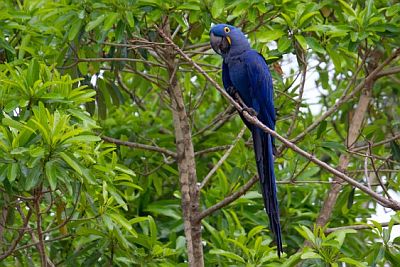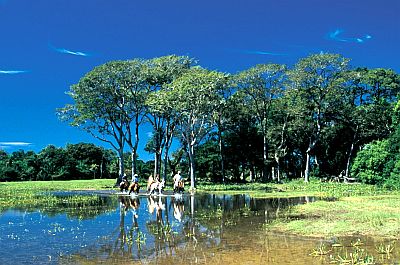Select units of measurement for the temperature and rainfall tables (metric or imperial).
Average weather, temperature, rainfall, sunshine hours
The climate of the Pantanal is
tropical, with hot, rainy summers and dry, sunny winters, characterized by warm days and cool nights. Being that it's in the Southern Hemisphere, the seasons are reversed when compared with Europe or North America.
Here are the average temperatures of the city of
Corumbá, located in the south-central part of the region.
Corumbá - Average temperatures (1991-2020) |
| Month | Min | Max | Mean |
|---|
| January | 24.2 | 33.6 | 28.9 |
|---|
| February | 24 | 32.7 | 28.4 |
|---|
| March | 23.6 | 32.7 | 28.2 |
|---|
| April | 22.2 | 32 | 27.1 |
|---|
| May | 19.3 | 28.5 | 23.9 |
|---|
| June | 18.7 | 27.9 | 23.3 |
|---|
| July | 17.6 | 28 | 22.8 |
|---|
| August | 19.6 | 30.8 | 25.2 |
|---|
| September | 21.4 | 32.8 | 27.1 |
|---|
| October | 23.4 | 34.1 | 28.8 |
|---|
| November | 23.5 | 33.8 | 28.6 |
|---|
| December | 24.2 | 33.6 | 28.9 |
|---|
| Year | 21.8 | 31.7 | 26.7 |
|---|
The
rains are concentrated in the warm period, from October to April, with a peak between November and March. The amount of rainfall varies between 1,000 and 1,300 millimeters (40 and 51 inches) per year; therefore, the Pantanal is not so rainy, yet it is the largest wetland in the world, since there are major rivers such as the Paraguay and its tributaries, which overflow in the rainy season.
Here is the average precipitation in Corumbá.
Corumbá - Average precipitation| Month | Days |
|---|
| January | 155 | 12 |
|---|
| February | 135 | 10 |
|---|
| March | 125 | 10 |
|---|
| April | 65 | 6 |
|---|
| May | 50 | 4 |
|---|
| June | 15 | 2 |
|---|
| July | 25 | 2 |
|---|
| August | 25 | 2 |
|---|
| September | 40 | 4 |
|---|
| October | 85 | 7 |
|---|
| November | 120 | 8 |
|---|
| December | 155 | 10 |
|---|
| Year | 1000 | 77 |
|---|
Most of the Pantanal is located in Brazil, in the states of Mato Grosso and Mato Grosso do Sul, but there is also a part in eastern Bolivia, along the border with Brazil, and a small portion in northern Paraguay. Since it hosts an extraordinary variety of plant and animal species (such as jaguars, capybaras, tapirs and hyacinth macaws), the Pantanal was declared a World Heritage Site by UNESCO in 2000.
 Winter
Winter, from mid-May to mid-August, is dry, with rare showers. During the, day it's hot, especially in the north (see Caceres), where the temperature normally fluctuates around 31/32 °C (88/90 °F), while in the southern part (see Corumbà), it remains lower, around 27/28 °C (81/82 °F). Sometimes, however, it can be very hot even in winter, with peaks of 35 °C (95 °F) in the south and 37 °C (99 °F) in the north.
Nights are usually cool, with minimum temperatures around 15 °C (59 °F) in the southernmost part, and possible mists or fogs at night, but they can sometimes be cold, when the wind blows from Argentina, so much so that the minimum temperature can reach as low as 0 °C (32 °F) in the southern part and 5/7 °C (41/45 °F) in the north.
In
spring, from mid-August to mid-November, the temperature begins to rise, so much so that it gradually becomes the hottest season of the year, especially in the north: in Caceres, the maximum temperature hovers around 34 °C (93 °F) between August and November, with peaks of 40 °C (104 °F); in the south, the temperature is lower by a couple of degrees Celsius (around 3.5 °F), but the peaks are equally around 40 °C (104 °F). In September, the first rains begin to show up, generated by the growing heat, but they reach a certain importance only in October, when they total about 100 mm (4 in) in the center-south and 130 mm (5.1 in) in the north.
Summer, from mid-November to late March, is hot, humid and rainy. Rainfall occurs mostly in the form of intense downpour or thunderstorm. In this period, floods make it difficult to get around. We already said that the hottest time of the year is the spring, at the end of the dry season, but in fact, sometimes the temperature can approach 40 °C (104 °F) also in summer, during hot and sunny periods, which can occur in this season as well.
In
autumn, from April to mid-May, there's a gradual decrease in both temperature and rain. Also, rivers return to their banks.

The amount of
sunshine in the Pantanal is not great, nor poor, in fact, the sun can shine in all seasons. Here is the average of the sunshine hours in Corumbá.
Corumbá - Sunshine hours| Month | Average | Total |
|---|
| January | 7 | 225 |
|---|
| February | 6.5 | 190 |
|---|
| March | 6.5 | 205 |
|---|
| April | 7 | 215 |
|---|
| May | 7 | 215 |
|---|
| June | 6.5 | 195 |
|---|
| July | 8 | 245 |
|---|
| August | 6.5 | 200 |
|---|
| September | 6 | 185 |
|---|
| October | 7.5 | 230 |
|---|
| November | 7.5 | 230 |
|---|
| December | 7 | 210 |
|---|
| Year | 7 | 2540 |
|---|
Best Time
The
best time to visit the Pantanal is the austral winter, from mid-May to mid-August, since it is the coolest and driest of the year. You should be equipped for the possible cold at night, and dress in layers because it can be hot during the day. Autumn, from April to mid-May, is a good period too: it is hotter, especially in April, there may be some more showers, but it is also less likely that it gets cold at night.